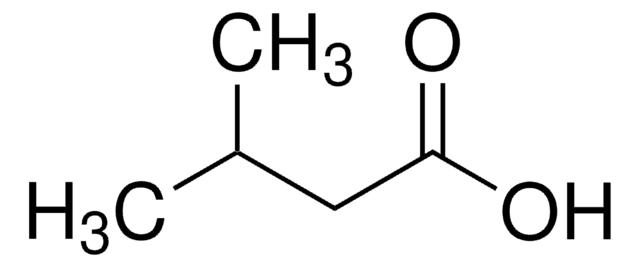P5561
Propionic acid
BioReagent, suitable for insect cell culture, ~99%
Sinonimo/i:
Acid C3, Propanoic acid, Propanyl acid
About This Item
Prodotti consigliati
Densità del vapore
2.55 (vs air)
Livello qualitativo
Tensione di vapore
2.4 mmHg ( 20 °C)
Nome Commerciale
BioReagent
Saggio
~99%
Temp. autoaccensione
955 °F
Limite di esplosione
12.1 %
tecniche
cell culture | insect: suitable
Indice di rifrazione
n20/D 1.386 (lit.)
P. eboll.
141 °C (lit.)
Punto di fusione
−24-−23 °C (lit.)
Solubilità
H2O: soluble
Densità
0.99 g/mL at 25 °C (lit.)
0.993 g/mL at 25 °C (lit.)
Stringa SMILE
CCC(O)=O
InChI
1S/C3H6O2/c1-2-3(4)5/h2H2,1H3,(H,4,5)
XBDQKXXYIPTUBI-UHFFFAOYSA-N
Cerchi prodotti simili? Visita Guida al confronto tra prodotti
Descrizione generale
Applicazioni
Avvertenze
Danger
Indicazioni di pericolo
Consigli di prudenza
Classi di pericolo
Eye Dam. 1 - Flam. Liq. 3 - Skin Corr. 1B - STOT SE 3
Organi bersaglio
Respiratory system
Codice della classe di stoccaggio
3 - Flammable liquids
Classe di pericolosità dell'acqua (WGK)
WGK 1
Punto d’infiammabilità (°F)
129.2 °F - closed cup
Punto d’infiammabilità (°C)
54 °C - closed cup
Dispositivi di protezione individuale
Faceshields, Gloves, Goggles, type ABEK (EN14387) respirator filter
Certificati d'analisi (COA)
Cerca il Certificati d'analisi (COA) digitando il numero di lotto/batch corrispondente. I numeri di lotto o di batch sono stampati sull'etichetta dei prodotti dopo la parola ‘Lotto’ o ‘Batch’.
Possiedi già questo prodotto?
I documenti relativi ai prodotti acquistati recentemente sono disponibili nell’Archivio dei documenti.
I clienti hanno visto anche
Il team dei nostri ricercatori vanta grande esperienza in tutte le aree della ricerca quali Life Science, scienza dei materiali, sintesi chimica, cromatografia, discipline analitiche, ecc..
Contatta l'Assistenza Tecnica.














